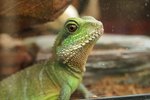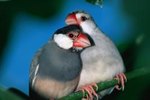
Although it may look rather bizarre to a human who is observing, throat puffing is a totally normal behavior for anole lizards. The family Polychrotidae notably includes both the green anole and brown anole species. Only male anole lizards engage in throat puffing, and generally only for sexual and territorial purposes.
Reaction to Danger in Anole Lizards
If a male anole lizard encounters something that he perceives to be a menace or danger, he will not hesitate to prominently fluff out his throat fan, which is also called a "dewlap." As he does this, he may also attempt to assert his status in a couple of other ways, including head nodding and moving sideways nearer to the source of danger. The "defeated" party in these cases generally displays his subordination by promptly leaving the scene.
Mating Activity in Anole Lizards
The mating season for anole lizards generally starts in the beginning of the spring and lasts until the very end of the summer. Throat puffing may be especially prevalent during those months, as it is a very common courtship behavior. In order to lure in females for breeding, male anoles frequently puff their throats out conspicuously as they engage in mating dances. The mating dances typically consist of push-ups, bobbing of the head and agape mouths -- the works.
Territorial Behaviors in Anole Lizards
Anole lizards are extremely territorial creatures. A male lizard's throat puffing may mean something as simple as him wanting an outsider to back off of his home turf. By expanding his throat, a male anole is making an attempt to appear physically bigger than normal -- and therefore, significantly more intimidating to his pesky opponent.
Boastfulness
The dewlap "show" of anole lizards has an element of boastfulness to it, as well. After all, these lizards' have very vividly colored throats. Green anole lizards (Anolis carolinensis), for instance, possess vibrant pink dewlaps. Brown anole lizards (Anolis sagrei), however, have orange, red or yellow throats -- all equally visually stunning. The throat coloration difference is an easy way to tell green anoles apart from brown anoles.
References
Photo Credits
-
Jupiterimages/Photos.com/Getty Images



